#Vertical farming techniques
Text
Vertical Farming Techniques and Advantages
Vertical farming techniques involve the cultivation of crops in vertically stacked layers or on vertically inclined surfaces, often in controlled indoor environments. These advanced systems utilize artificial lighting, climate control, and hydroponic or aeroponic systems to optimize plant growth.
One key advantage of vertical farming is efficient space utilization. By growing plants vertically, it maximizes land use and allows for higher crop yields per square meter compared to traditional farming methods. This is particularly beneficial in urban areas where space is limited.
Another advantage is the year-round crop production capability of vertical farming. It is not dependent on seasonal changes or weather conditions, as the controlled environment provides consistent and optimized growing conditions. This ensures a stable and reliable supply of fresh produce throughout the year.
Vertical farming also reduces the need for pesticides and herbicides since the controlled indoor environment minimizes the risk of pests and diseases. Additionally, water usage is significantly reduced in vertical farming due to efficient irrigation systems like hydroponics or aeroponics, where water is circulated and reused.
Moreover, vertical farming offers the potential for localized food production, reducing transportation costs and carbon emissions associated with long-distance food distribution. It also allows for the cultivation of a wide range of crops, including leafy greens, herbs, and even some fruits, providing fresh and nutritious produce locally.
Overall, vertical farming techniques offer numerous advantages, including efficient space utilization, year-round crop production, reduced pesticide use, water efficiency, and the potential for localized food production. These benefits contribute to sustainable and resilient agricultural systems in urban environments.
#Vertical farming techniques#farmer#farming#agriculturetechnology#agripreneur#farmingtechnologies#agriculture#organicfarmer#cannabisresearch#agriculture technology#organicfarmerofmillionaire#vertical farming techniques
1 note
·
View note
Text
Unlocking the Potential of Vertical Farming: Watch Our Exclusive Video!
🌱🏙️ Discover the future of farming with our exclusive video on the benefits of vertical farming! 🎥
🌱🏙️ Discover the future of farming with our exclusive video on the benefits of vertical farming! 🎥
Vertical farming is reshaping the landscape of agriculture, offering innovative solutions to the challenges of food production in urban environments. Our video dives deep into the world of vertical…

View On WordPress
#Agriculture#Farming Techniques#Food Production#NPower Farmers#NPowerFarmers#Sustainable Agriculture#Urban Farming#Vertical Farming
0 notes
Text
Farming Become Easier in Modern Times | Niche Agriculture

Modern Farming Techniques 2024
In the ever-evolving landscape of agriculture, staying abreast of modern farming techniques is crucial for maximizing productivity and sustainability. From precision agriculture to vertical farming, this comprehensive guide explores cutting-edge methods that can revolutionize your farming practices in 2024 and beyond.
Innovative Precision Agriculture:
Embrace the power of precision agriculture to optimize resource utilization and enhance crop yields. With GPS-guided machinery and advanced sensors, you can precisely monitor soil conditions, moisture levels, and crop health in real-time. By leveraging data-driven insights, you'll make informed decisions on seed placement, irrigation schedules, and nutrient application, leading to increased efficiency and profitability.
Unlocking Vertical Farming Potential:
Discover the potential of vertical farming to overcome land constraints and meet the demands of urbanization. By stacking crops in vertical layers within controlled environments, you'll maximize space utilization and minimize environmental impact. LED lighting and hydroponic systems ensure optimal growing conditions, allowing for year-round production of fresh, nutritious crops. Embrace vertical farming to cultivate a diverse array of vegetables, herbs, and even fruits in urban settings, promoting local food security and reducing transportation emissions.
Sustainable Practices for Future Success:
Incorporate sustainable farming practices into your operations to safeguard the environment and ensure long-term viability. Implement conservation tillage techniques to minimize soil erosion and improve soil health. Embrace cover cropping and crop rotation to enhance nutrient cycling and suppress weeds naturally. Explore regenerative agriculture principles to rebuild soil organic matter and sequester carbon, mitigating the impacts of climate change. By prioritizing sustainability, you'll not only protect the planet but also future-proof your farming enterprise against emerging challenges.
Harnessing Technology for Efficiency:
Leverage the latest advancements in agricultural technology to streamline your workflow and boost efficiency. From automated irrigation systems to drone-assisted crop monitoring, technology offers unprecedented opportunities to save time and resources. Embrace farm management software to track expenses, monitor yields, and analyze performance metrics, empowering you to make data-driven decisions with confidence. Embrace robotics for labor-intensive tasks such as planting, harvesting, and weed control, freeing up your time to focus on strategic planning and innovation.
Conclusion:
In today's fast-paced agricultural industry, mastering modern farming techniques is essential for success. By embracing precision agriculture, vertical farming, sustainable practices, and technology-driven solutions, you'll unlock new levels of productivity, profitability, and sustainability. Stay ahead of the curve by adopting innovative approaches that position your farm for success in 2024 and beyond.
#Modern Farming techniques#Modern Farming techniques 2024#Niche Agriculture Farming Techniques#Vertical Farming Potential
1 note
·
View note
Text
कम जमीन हो तो इजराईली तकनीक से करें खेती, होगी मोटी कमाई
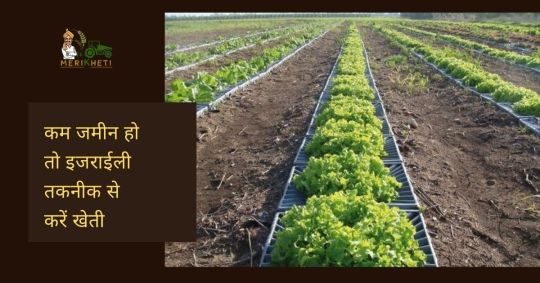
अगर जमीन कम हो तो किसान सोच में पड़ जाता है कि कैसे खेती से ज्यादा कमाई होगी. लेकिन जमीन के छोटे टुकड़े में भी खेती करके अधिक पैदावार प्राप्त किया जा सकता है.
कम जमीन पर भी ज्यादा पैदावार प्राप्त करना मुश्किल है पर नामुमकिन नहीं है. इसको लेकर लगातार प्रयोग किया जाता रहा है. भारत ही नहीं विदेशों में भी कम जमीन में अधिक उपज प्राप्त करने को लेकर प्रयास किए जाते रहे हैं. इस क्षेत्र में इजराईल ने महत्वपूर्ण उपलब्धि हासिल की है.
कम भूमि में खेती कर अधिक उत्पादन प्राप्त कर इजराइल ने बनाया मिसाल
इजराइल एक ऐसा देश है जो अपने नवीन अनुसंधानों के लिये जाना जाता है और इसी के कारण निरंतर चर्चा में रहता है. रक्षा के क्षेत्र में हो या स्वास्थ्य के क्षेत्र में इजराईल हमेशा नए नए कीर्तिमान स्थापित करता रहा है. अब कृषि के क्षेत्र में उसके प्रयोग ने सारी दुनिया का ध्यान अपनी ओर खींचा है. आजकल इजरायल द्वारा विकसित की गई वर्टिकल फार्मिंग (Vertical farming) की आधुनिक तकनीक काफी चर्चा में है और यह तकनीक देश-विदेश में काफी लोकप्रिय हो रही है.
क्या है वर्टिकल फार्मिंग की आधुनिक तकनीक ?
वर्टिकल फार्मिंग की आधुनिक तकनीक के तहत कम जगह में दीवार बनाकर खेती की जाती है. वर्टिकल फार्मिंग की आधुनिक तकनीक के तहत सबसे पहले लोहे या बांस की मदद से दीवार नुमा ढांचा खड़ा किया जाता है. ढांचे पर छोटे-छोटे गमलों को खाद, मिट्टी और बीज डालकर करीने से रखा जाता है. इसके पौधों की रोपाई नर्सरी की तरह भी गमलों में की जा सकती है.
ये भी पढ़ें: मिट्टी के बिना खेती करना नहीं रहा असंभव : पटना के व्यक्ति ने किया यह संभव
बहुत उपयोगी है ये वर्टिकल फार्मिंग तकनीक
कम जमीन और कम संसाधनों में खेती करने के लिए यह एक बहुत उपयोगी विकल्प है. हालांकि भारत जैसे देशों में खेती के लिए पर्याप्त उपजाऊ जमीन मौजूद है लेकिन विश्वा में बहुत से देश ऐसे हैं जहाँ खेती योग्य जमीन की कमी है. इजराइल के पास भी खेती योग्य जमीन कम है जिसके कारण उसे खाद्यान्न आपूर्ति के लिए अन्य देशों पर निर्भर रहना पड़ता है. इसी को देखते हुए इजराईल नें वर्टिकल फार्मिंग की आधुनिक तकनीक का इजाद किया जो कम भूमि संसाधनों वाले देशों के लिए वरदान सिद्ध हो रहा है.
चीन, कोरिया, जापान, अमेरिका, यूरोप और ऑस्ट्रेलिया जैसे देश भी इस तकनीक को सफलतापूर्वक अपना रहे हैं. बड़े शहरों में अच्छी और ताज़ी सब्जियों की आपूर्ति करना थोड़ा मुश्किल होता है क्योंकि दूर दराज के गांवों से लाया जाता है. वर्टिकल फार्मिंग के द्वारा अब शहरों में ही वर्टिकल फार्मिंग द्वारा सब्जियों को उगाकर मांग की आपूर्ति करना आस��न होता जा रहा है.
ड्रिप इरीगेशन से होती है पानी की बचत
इजरायल द्वारा ही सिंचाई तकनीक ड्रिप इरीगेशन या बूंद-बूंद सिंचाई पद्धति इस तरह की खेती के लिये उपयोगी होता है. इससे पानी की बर्बादी भी बचती है और पौधों में जरूरत के मुताबिक पानी दिया जाता है. इस तकनीक का उपयोग अब भारत में भी होने लगा है. इस तकनीक के जरिए अनाज, सब्जियां, मसाले और औषधीय फसलें सभी कुछ उत्पादित की जा रही हैं. इस तकनीक का दूसरा लाभ ये है कि इससे पौधों में कीड़े और बीमारियों का खतरा भी कम हो जाता है.
ये भी पढ़ें: जानिए क्या है नए ज़माने की खेती: प्रिसिजन फार्मिंग
वर्टीकल फार्मिंग रोजगार का भी है माध्यम
बहुत कम जगह में उत्पादन की क्षमता के कारण वर्टीकल फार्मिंग का यह तकनीक शहरी क्षेत्रों के लिए बेहद लाभदायक है. हांलाकि वर्टीकल फार्मिंग में खर्च परंपरागत खेती से ज्यादा है लेकिन यह भी सच है की इससे लाभ भी ज्यादा है. यही कारण है कि मुंबई, पुणे, बेंगलुरु, चेन्नई और गुरुग्राम जैसे बड़े शहरों के लोग नौकरियां छोड़कर वर्टिकल फार्मिंग को अपना रहे हैं क्योंकि उन्हें अच्छा मुनाफा प्राप्त हो रहा है.
इको फ्रेंडली वर्टीकल फार्मिंग
वर्टीकल फार्मिंग तकनीक जहां कम जमीन में खेती के लिए लाभदायक है, इससे वायु प्रदूषण, ध्वनि प्रदुषण भी कम होता है और पानी एवं अन्य संसाधनों की भी बचत होती है. शहरों में अपनाए जाने के कारण हरियाली तो बढाती ही है साथ ही पर्यावरण को शुद्ध रखने में ये सहायक है. शहरों में उत्पादन करने से परिवहन लागत भी कम हो जाती है.
source कम जमीन हो तो इजराईली तकनीक से करें खेती, होगी मोटी कमाई
#israel technique se kheti#Israels farming technique#vertical farming#इको फ्रेंडली वर्टीकल फार्मिंग#इजराइलवर्टिकल फार्मिंग
0 notes
Photo

The Sweet Track
The Sweet Track is a Neolithic timber walkway, located in the Somerset Levels, England. It was originally part of a network of tracks built to provide a dry path across the marshy ground. The Sweet Track ran between what was then an island at Westhay to a ridge of high ground, close to the River Bruce. The remains of mounds have also been found at Westhay, indicating the remains of a settlement.
About 1.6 kilometres (1 mile) long, the Sweet Track was discovered in the 1970s CE during a peat excavation by Ray Sweet, (who also gave the track its name). Using dendrochronology (tree-ring dating) the track has been dated 3807/3806 BCE. For many years it was thought to be the oldest trackway in Northern Europe, until 2009 CE when a slightly older one was discovered in Plumstead, London.
The Somerset Levels are an area of wetlands and peats. The conditions of such areas can naturally lead to the preservation of organic materials. Materials become encased in a wet and airless environment, thus preventing, to a degree, decomposition. Wooden artefacts and structures have been recovered from the Levels, as well as the two well-preserved Iron Age villages of Glastonbury and Meare.
The track would have been built by a community of Neolithic farmers living in small settlements. Farming had spread from the Middle East and by this point was firmly established in Britain. According to pollen evidence, the whole of Britain would have been covered in forests at this time. The Neolithic peoples would have burnt and cleared the forests to have the land on which to grow their crops, mostly grains. A fair degree of organization is evident in the stockpiling of wood and construction of the tracks, and some members of the community would have had to have skills in woodworking. Using stone and flint axes, the trees for the track were cut on dry land with different cutting techniques used, depending on their age. Older oaks were cut vertically whilst younger trees tangentially. Modern research has been carried out using replica axes and the cut marks have also been studied to establish the methods of cutting used. The planks of wood were put together in the marsh, the final construction taking about a day to complete. Long poles were driven slantwise into the ground and then planks were laid in between, held in place by vertical pegs. The planks were made of oak, ash and lime. The poles and pegs were made mainly of hazel and alder. There are also remains of another track, known as the “Post Track”, which dates 30 years earlier than the Sweet Track, 3838 BCE. It ran roughly parallel to the Sweet Track, possibly used by the builders of the Sweet Track as an access route.
Artefacts have been found beside the track, among them, pottery and axe heads including one made of jadeite. Whether they had been deliberately buried, perhaps as an offering, or just lost, remains unknown. There have been many Prehistoric trackways found in England, but more than half reside in Somerset. Included in these are the Abbot's Way, Eclipse, Honeygore, Meare Health and Garvins tracks. They were constructed using varying styles, such as corduroy - laying short logs parallel to each other and side by side. The Sweet Track is the most well-known of these. It has been declared a scheduled monument (of national importance). Most of it remains in its original location and requires constant conservation to keep the wood in its damp condition. There are reproductions and a donated section now resides in the British Museum, London.
Continue reading...
35 notes
·
View notes
Text
Closing Loops in Soilless Gardening - Hydroponics and Aquaponics
What is the future of food production going to look like? Is the projected 10 billion people in 25 years, out of which two thirds will live in cities, going to require us to convert every square meter of arable land into intensive mono cultural farms? Please don't let that be true! There HAS to be some alternative. Fortunately, there are several. Two of them are different ways of growing plants without soil, a radically new method, which may be most appealing to urban food production.

image source
Hydroponics: Growing Plants in Water
When it comes to growing large amounts of food on a small area efficiently, hydroponic systems are often brought up as a solution. And the reasons sound pretty convincing: An efficient hydroponic farm uses 90% less water, and can yield 3-10 times the amount of produce per area, with 7-14 growth cycles in a year. IMPRESSIVE! But before getting too excited, let's not forget: the devil is in the details! It's worth looking into under exactly what conditions those plants grow, being fed by what light, and most importantly which nutrients, and where they come from.
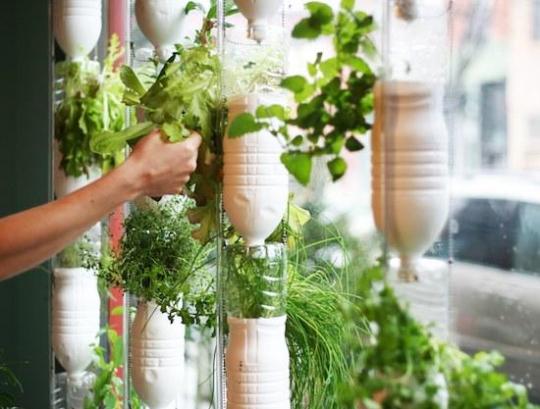
image source
The basic concept, however, of growing plants vertically, in mostly water, with some kind of substrate, such as clay balls or vermiculite, is actually a pretty nifty way to grow food where there are no fields. The most basic form of this may be the Windowfarm technique, which I experimented with myself years ago in my Budapest apartment. Going to Shanghai, the whole idea seems to be taken to a whole new level.
https://static.dezeen.com/uploads/2017/04/sunqiao-urban-agricultural-district-Sasaki-architecture-industrial-china-shanghai_dezeen_hero-b.jpg
image source
Is That Really Sustainable? Or Even Healthy?
… not to mention, does hydroponics even fit into Permaculture? Because let's be honest: with a system that needs to be constantly managed and monitored you could not be further from a self-supporting ecosystem. Also, what exactly do those plants get to eat? The typical N-P-K made industrially out of petrochemicals? Most likely. So while it certainly reduces the transport related drawbacks, hydroponics is by no means energy efficient, and the nutritional value won't be any better than your most industrially grown veggies.

image source
How Does Aquaponics Compare?
Okay, so let's bring in the fish! For those not familiar with the difference between the two systems, aquaponics is the combination of hydroponics and aquaculture, which are simply fish farms. Having fish in a tank, they will naturally defecate into the water, requiring it to be changed regularly. Plants, however love to eat those nutrients that the fish excrete. Or to be more exact, they feed on the nutrients that have been converted by bacteria and other microbes. The ammonia will turn in to nitrites, which in turn become nitrates, that is food for the plants.
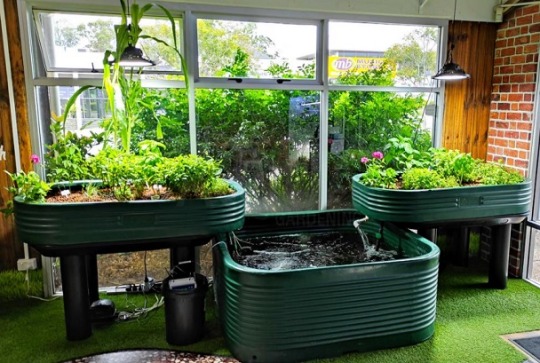
image source
So running the water from the fish through the plants growing substrate will on one hand feed the plants, as well as clean it for the fish to enjoy it again. So the system already closed a few loops there, making it more sustainable than just mere hydroponics. Also, the inclusion of microbes already offers a more diverse environment, bringing the system a bit closer to an ecosystem. But let's not get ahead of ourselves: Aquaponic systems still need close monitoring, as they are still a far cry from a self sustaining ecosystem of let's say a pond. Also, the water circulation / aeration is most likely going to require a pump, and depending on the exact setup of the system, maybe artificial lighting for the plants. All these aspects add to the energy requirement of the aquaponic system.
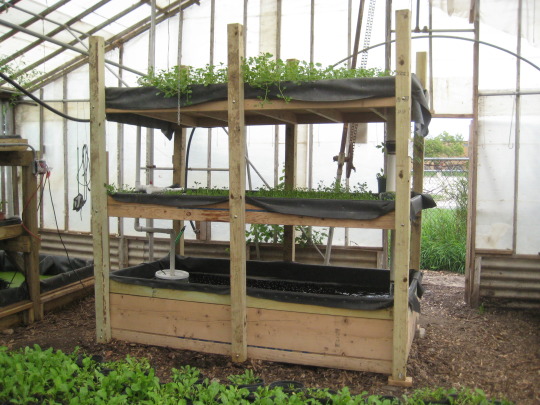
image source
A Truly Closed Loop? Consider the Food of the Fish!
When praising the sustainability of aquaponics, one thing that mustn't be ignored is the source of the fish food. Just like with the hydroponic systems, where the food for the plants or the fertilizer is considered, we can't ignore the feed we give to our fish to eat. If it is the same industrial feed, we may as well have kept to our hydroponics. Not true, since including fish already makes our system more diverse. So instead, let's continue in that same direction. What do fish eat? What is good for them? How can we grow that food ourselves?

image source
Making Your Own Sustainable Fish Food
Here I could probably start a number of individual posts, since talking about fish food is like opening up a can of worms. But fortunately, I already have a number of appropriate things written. Talking about worms, by the way, anyone who has been fishing knows that they are a favored delicacy, and anyone who composts will have no shortage of them. Since worms are mostly vegetarians, and many of us eat meat, it may have been a bit difficult to properly compost greasy, meaty, bony food wastes. That's where black soldier flies come in, whose larvae are also frequently mentioned for fish food. I still need to try growing those guys. As for green plants for the fish, duckweed makes also good fish feed, again something I have no experience with. What I do know, though, is spirulina, which is also super rich in nutrients, and I would be surprised if the fish didn't like it. So I can see throwing some composting worms, black soldier fly larvae, and spirulina into a blender, to make some great nutritious fish food. At the moment this is very theoretical for me, though.

image source
Don't Give Up the Soil Completely
So does this mean we should all focus on setting up our most sustainable fish-plant-compost combo cycles? Hells yeah! But please not at the expense of everything else! Soilless gardening, as exciting and revolutionary as it may sound, is still that: without soil. And let's face it: neither us, nor our beans and tomatoes, have evolved to live entirely without soil. That just seems wrong. Even in a small urban apartment it's worth having a bit of soil on your roof, balcony, or window sill, where you can dig your hands into a world of healthy microbial diversity on occasion. And if you do have the space, by all means, set up a pond, a dam, or another aquatic ecosystem, where fish, and frogs, and dragonflies, and numerous other species can live together without relying on our management. Apart from looking pretty, they will also provide food for us, that is nutritionally superior to anything industrially grown.
Sources: 1, 2, 3, 4, 5, 6, 7, 8
115 notes
·
View notes
Text


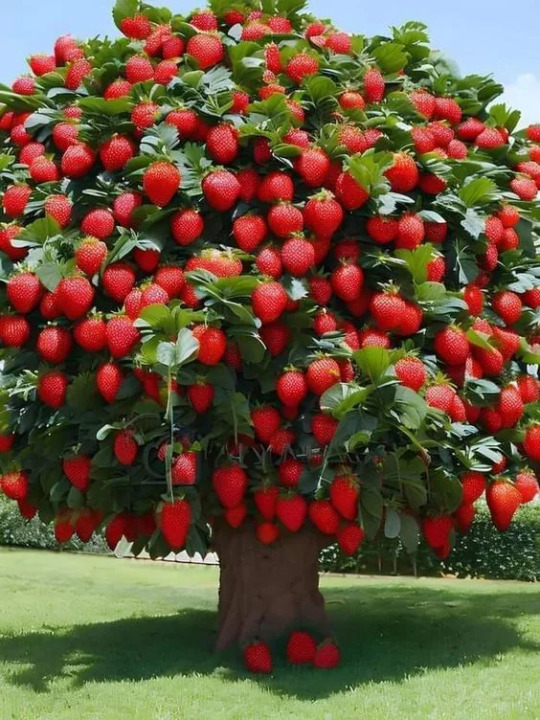

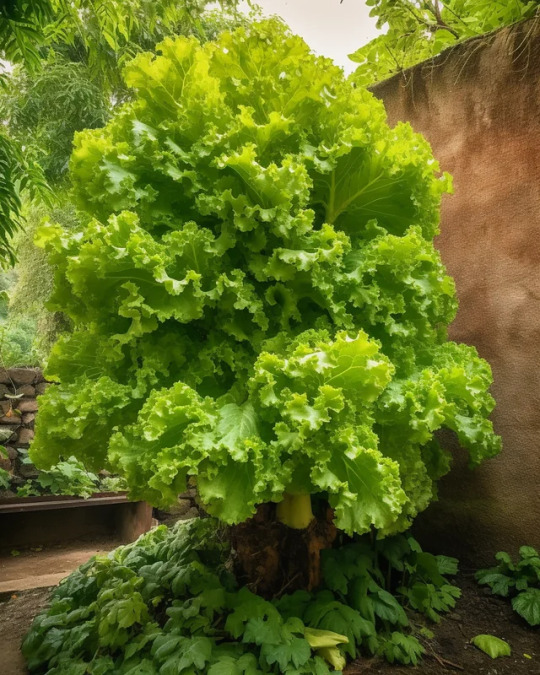
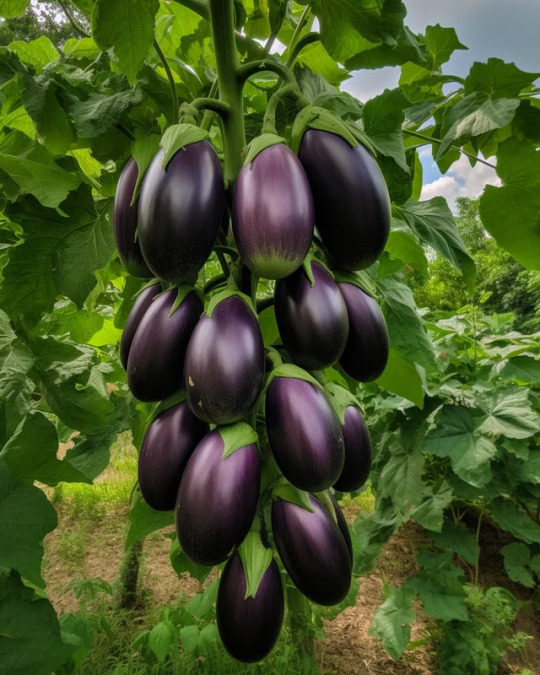
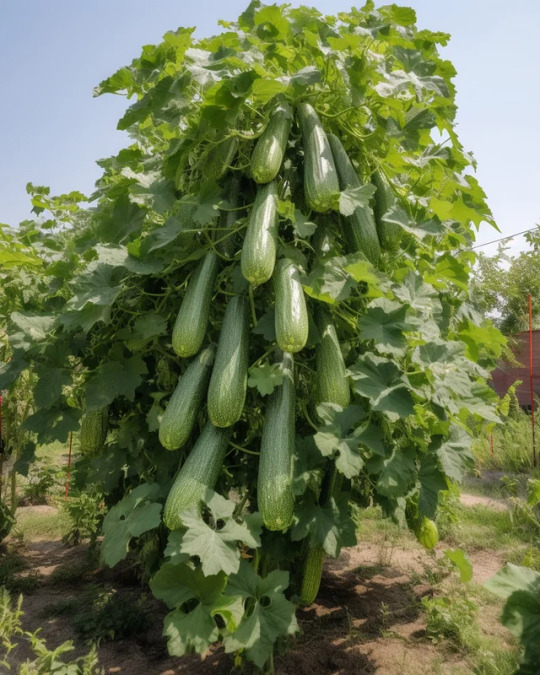
vertical farming...
Vertical farming is the practice of growing crops in vertically stacked layers.
It combines hydroponic farming techniques such as hydroponics, aquaponics and aeroponics, and controlled-environment farming aimed at optimizing plant growth.
......
Dikey tarım...
Dikey tarım ürünleri dikey yığılı katmanlarda ürün yetiştirme uygulamasıdır.
Hidroponik, aquaponik ve aeroponik gibi topraksız tarım tekniklerini ve bitki yetiştirmeyi en uygun yapmayı hedefleyen kontrollu-ortam tarımını birleştirir.
#türkiye#doğa#travel photography#travel destinations#travel#manzara#view#natural#europe#africa#Spotify
24 notes
·
View notes
Text
@oligopsoriasis I don't know if you're still interested in the farming thing, but, regarding your land efficiency vs. energy-efficiency thing:
My impression is that, when designing an agricultural system, the basic trade-off is labor against land area, i.e. you can reduce labor inputs by using more land and reduce your land footprint by sinking more labor into it.
In this framing, I think industrial row-crop monocultures are extensive rather than intensive, i.e. they sacrifice land to save labor as well as/rather than energy to save land. Sustainability and higher absolute production might well not mean using more land.
A lot of the articles and papers that talk about modern sustainable systems trumpet them as Actually Much More Efficient than “industrial” agriculture, when, really, they’re just opting for the other end of the ancient trade-off -- they lead with productivity statistics calculated entirely on land use, and quietly note somewhere down below that “of course, this takes vastly more work, and is devilishly complicated to maintain...”
But that doesn’t mean they aren’t a better bet! The point is, there are trade-offs to be made other than technology-i.e.-what-we-have-now/primitivism. It means we’d need more greenhouse-minders and algae-scrapers, yes, maybe even more people growing beans in raised beds, but that’s Jobs, not a return to peasant agriculture.
(I’m not really considering the original thing about hunting, meat just doesn’t seem likely to ever be efficient, except on marginal lands, where it couldn’t support modern population densities, alligators or no.)
[some rambling speculation about historical intensive systems:]
Anyway, historically, intensive, labor-heavy, small-land-footprint systems make sense if you have a lot of labor and not a lot of land, and include the various clever Native American polyculture systems (the chinampa, the three sisters), but also potato-farming (Ireland, before the famine, being prototypically labor-rich and area-poor: a densely-populated, highly fertile area in which people had to subsist on glorified garden-plots), modern Dutch-style greenhouse fruit/veg/cash-crop cultivation, maybe what the Cubans do. Wet rice cultivation and terrace-farms are possibly in this category. “Vertical farming”, if it’s not a nothingburger, probably will be too (multistory buildings are capital, capital is dead labor, lotta walking up stairs, etc.).
(Classic Geertzian involution is when you can’t get any more intensive, so you have to sink more people, more bodies, more hours into it, without hope of improving productivity per head.)
My conjecture is that intensive systems make more sense when you don’t have draft animals to give you access to a larger area and incentivize more drivable open layouts and planting/harvesting techniques.
#politics#history#agriculture#edited bc it sounded like the last paragraph was referring to involution#rather than intensive agriculture
81 notes
·
View notes
Text
Horticulture definition & Branches
Horticulture is a subfield of agriculture that focuses on the cultivation, management, and study of plants used for non-food purposes like medicine or industry. It also includes non-food crops like flowers and ornamental plants. In order to produce high-quality and profitable crops for a variety of uses, including food production, landscaping, ornamental adornment, and more, it involves a wide range of plant-related operations, including planting, breeding, irrigating, growing, harvesting, and post-harvest processing. Horticulture is a broad field that includes everything from modest backyard gardens to extensive commercial operations, and it frequently entails the use of specialized knowledge and techniques to improve the growth and development of plants.
Enhancing the quality, quantity, nutritional value, and aesthetic appeal of plants—whether they are cultivated for food, medicine, ornamentation, or other purposes—is the aim of horticulture. To maximize the growing conditions and productivity of plants, horticulturists use a variety of procedures, including breeding, grafting, pruning, and pest management.
Pomology: This branch of horticulture is concerned with the cultivation of fruits. Pomologists study the production, storage, processing, and marketing of fruit crops such as apples, citrus fruits, grapes, and berries.
Olericulture: Olericulture is the branch of horticulture that deals with the production and cultivation of vegetables. It includes the study of vegetables from seed production to harvesting, storage, and marketing. Common vegetables studied in olericulture include tomatoes, lettuce, carrots, and onions.
Floriculture: Floriculture focuses on the cultivation of flowering and ornamental plants for their aesthetic and decorative qualities. This branch includes the production of flowers, cut foliage, potted plants, and landscaping materials. Floriculturists often work in the floral and landscaping industries.
Viticulture: Viticulture involves the cultivation of grapes for wine, raisins, and table grapes. This branch covers various aspects of grape production, including vineyard management, pest control, and the study of grape varieties suitable for different purposes.
Oenology: While not strictly a branch of horticulture, oenology is closely related as it involves the study of wine and winemaking. Oenologists focus on fermentation processes, wine chemistry, and sensory evaluation to produce high-quality wines.
Pest Management: This branch is concerned with the study of pests that affect horticultural crops and the development of strategies to manage and control these pests. Integrated Pest Management (IPM) is an approach that combines biological, cultural, physical, and chemical control methods to minimize the impact of pests on crops.
Post-Harvest Physiology and Technology: This branch deals with the handling, storage, transportation, and processing of horticultural crops after harvest. It aims to maintain the quality and freshness of produce from the farm to the consumer.
Urban horticulture: This field of study focuses on the special difficulties and opportunities associated with cultivating plants in urban settings. In order to improve urban green spaces, it includes endeavors like rooftop gardening, vertical gardening, and community gardening.
Seed Science and Technology: Seed science involves the study of seeds, including their development, germination, storage, and viability. Seed technologists focus on the development of high-quality seeds for improved crop production.
Turf Management: Turf management is concerned with the cultivation and maintenance of grasses for lawns, sports fields, and other recreational areas. It involves aspects such as mowing, fertilization, pest control, and irrigation.
These different types of horticulture demonstrate the diversity of plant-related activities and the important role they play in providing food, beautifying landscapes, supporting the economy, and contributing to human well-being. Horticultural practices continue to evolve with advances in science and technology, contributing to improved crop yields, sustainability, and overall quality of plant products.
Kindly visit for more - https://krishilearning.com/branch-of-horticulture/
What you"ll discover here -
Educational Resources - Our blog serves as a treasure trove of educational content, including articles and lesson plans, all designed to enhance your understanding of agricultural principles, practices and new technology in agriculture. We explore cutting-edge technologies, such as hydroponics, aquaponics, precision farming, and more, to help you stay ahead in the ever-evolving world of agriculture.
We have designed our website to be user-friendly, making it easy for you to navigate, access, and engage with our content. We value your user experience.
Join Us in Cultivating Knowledge
Whether you are a farmer, a student, a teacher, or simply someone interested in the world of agriculture, krishilearning is here to guide you on your educational journey. Together, we can foster a more sustainable, innovative, and prosperous agricultural sector. Join us in cultivating knowledge, growing communities, and embracing the future of agriculture.
2 notes
·
View notes
Text
“It’s kind of a last-man-standing situation,” says Fred Thiel, CEO of US-based Marathon Digital Holdings. His crypto-mining company, among the largest in the world, has found itself—like the rest of the industry—in the path of a perfect storm.
Over the past year, the sector has been battered by a slump in the price of bitcoin, combined with a spike in the cost of energy and an increase in mining difficulty—a reflection of the amount of computing power directed at the bitcoin network, which dictates the proportion of coins miners are able to win.
At the height of the 2021 boom, profit margins in the mining business rose as high as 90 percent, says Thiel. But now, they have “totally collapsed.” If the price of bitcoin does not rally, he says, there will be “a lot more pain,” and firms that are only marginally profitable today will find themselves “very underwater.”
As they scramble to cut costs, miners are playing a high-stakes game of chicken. In spring 2024, the halving, a mechanism baked into the bitcoin system that periodically cuts the number of coins awarded in half, will slash mining profits. The goal for miners is to ensure they are in a strong enough financial position to survive the fall in profits longer than anyone else; as miners give in and drop from the network, the share of coins won by the rest will increase.
“Any miners that are struggling now will not be able to survive the halving,” says Jeff Burkey, VP of business development at Foundry, which operates its own mining facilities, a large-scale mining pool, and a marketplace for mining hardware. The dynamic will create a rush among miners to get their houses in order, he explains.
Miners will look to eke out additional profit margin wherever they can, whether by deploying superior hardware and cooling techniques, developing software to closely monitor the performance of machines, relocating to territories with cheaper power, or renegotiating the terms of their loans.
Others, like Geosyn Mining, are aiming at vertical integration—all the way down to the energy powering the facilities. The company, says CEO Caleb Ward, wants to construct its own solar farm to power its machines, thereby eliminating a major cost. “We need to be more thoughtful as an industry about how we protect against risk,” he says. “It’s not all about shooting for the moon.”
Meanwhile, the miners whose financial predicaments prevent them from fine-tuning their operations are playing a dangerous waiting game, gambling on an increase in the price of bitcoin that may never come.
“The beauty of halving cycles is that the industry [is forced] to become more efficient—a lot of weaker players will have to exit the business,” says Jeff Lucas, CFO of mining company Bitfarms, which has worked to restructure its finances in the downturn. “The devil is in the details.”
Already on the back foot, mining companies are beginning to fold. Compute North, which owned multiple large-scale mining facilities, filed for bankruptcy in September, and Core Scientific, a publicly traded miner, did the same in December. Others are having to maneuver. Argo Blockchain, also a public company, was forced to sell off mining equipment and its state-of-the-art mining center, while Stronghold Digital Mining has negotiated a debt repayment holiday. Neither company responded to interview requests.
A combination of “immaturity, poor planning, and greed” has led miners to the brink of collapse, says Phil Harvey, CEO of Sabre56, a crypto-mining consultancy firm that also operates its own facilities. While the market was hot, companies took on large amounts of debt at high interest rates (10-20 percent) to finance expansion, says Harvey, and now the value of the coins they earn is insufficient to cover the costs of repayments.
Historically, a steep rise in the price of bitcoin, triggered by a buying frenzy, has been followed by a sharp fall and then a gradual recovery. Although there is no guarantee this pattern will repeat, the process is widely described as the bitcoin cycle. The fatal mistake, says Jaime Leverton, CEO of mining company Hut 8, was to imagine that that 2021 was different—that the industry was in a “supercycle” that was going to “break prior cycles” and extend the hot streak. A lot of people bought into this idea, she explains, and so were caught off-guard when the market tanked.
In an effort to strengthen its own position, Hut 8 is in the process of merging with US Bitcoin, another mining firm. The goal, says Leverton, is to minimize risks associated with the volatility of bitcoin by diversifying both revenue streams and the regions in which the business operates.
Whereas Hut 8 only has facilities in Canada and mines exclusively for itself, US Bitcoin runs mines across the US and hosts mining hardware for third-party customers alongside other auxiliary services. “It’s important to be dynamic,” says Mike Ho, cofounder of US Bitcoin. “There is an optimal strategy, depending on the price of bitcoin. It’s about knowing how to navigate through the cycle at different stages.”
Recognizing the trajectory of the market, other companies have sought to eliminate outstanding debt as rapidly as possible. In the summer of 2021, Bitfarms had $165 million of debt on its books, at interest rates between 16 and 18 percent. Lucas says it may seem “absurd” to stomach these exorbitant rates, but it “made sense” because the cost of debt was eclipsed by the revenue generated by mining activity—at least until it wasn’t.
“As revenues came down dramatically with the price of bitcoin, there was still a high debt to pay for,” he says. “And that put a squeeze on a lot of companies.”
In June 2022, Bitfarms began to sell down the bitcoin in its treasury to eliminate its debt. Earlier this month, the firm also managed to negotiate down a $21 million debt to bankrupt crypto lender BlockFi that was instead paid off in a single $7.75 million cash payment. The company’s approach to slashing debt, coupled with a focus on maximizing the efficiency of its mining rigs, says Lucas, will put Bitfarms in good stead to weather the remainder of the crypto winter.
The scramble among miners to balance the books has attracted the attention of other market participants hoping to increase their market share at a reduced price. Investment firm Galaxy Digital has long been eager to expand its bitcoin-mining operations. Sensing an opportunity, the company swooped in to grab Argo’s flagship Helios mine in December, spending $65 million for a facility reported to have cost at least $1.5 billion to build.
Mergers, acquisitions, and collapses will continue to be a theme, says Alex Mologoko, analyst at blockchain intelligence company Elementus, until “all economically unsustainable mining operations are weeded out.”
9 notes
·
View notes
Text
Homesteading for the Homeless:
How Converting Empty Commercial Spaces into Indoor Farms Can Address Food Insecurity and Unemployment
The COVID-19 pandemic has led to high vacancy rates for commercial spaces in metropolitan areas, especially malls and skyscrapers. At the same time, homelessness remains a significant issue, especially in coastal cities. One solution to address both these problems is to convert empty commercial spaces into indoor farms and communal living areas for homeless Americans, owned and operated by their workers.
Indoor farming has emerged as a sustainable and efficient method for producing high yields of crops in a small space, regardless of weather or climate conditions. Vertical farming, a method of growing crops in vertically stacked layers, has gained popularity in recent years as a way to maximize space and improve efficiency. Repurposing vacant commercial buildings could create a new industry that addresses food insecurity while providing employment for the homeless.
According to a report from CBRE, the United States had a 16.4% office space vacancy rate at the end of 2020, the highest it has been since 2011. The retail sector was also struggling, with a national vacancy rate of 10.5% in the first quarter of 2021. Meanwhile, homelessness remains a significant issue in coastal cities, with an estimated 580,466 people experiencing homelessness in January 2020, according to the Department of Housing and Urban Development.
Startups in the vertical farming industry have been on the rise in recent years. According to AgFunder, an online platform that connects investors with agtech startups, there were over 60 vertical farming startups that raised over $1.2 billion in funding in 2020. These startups are using innovative techniques to grow crops in urban areas, close to consumers, and reduce transportation costs and emissions.
Converting vacant commercial buildings into indoor farms using vertical farming techniques would provide employment for the homeless and communal living spaces. However, these indoor farms could also be operated as worker-owned commercial enterprises. Communal living spaces for homeless individuals would provide a sense of community and stability, as well as a chance to learn valuable skills through participation in the farming process. By operating the indoor farms as worker-owned enterprises, homeless individuals could take ownership of their work and have a say in the direction of the business.
Homesteading using vertical farming is an opportunity to work with individuals who share the same interests and values. For young people, WWOOF (World Wide Opportunities on Organic Farms) provides opportunities to travel around the world and learn about sustainable agriculture practices. Similarly, converting commercial spaces into worker-owned indoor farms could create new opportunities for homeless individuals to participate in the farming process and learn valuable skills, while also taking ownership of their work.
While there are challenges to converting commercial buildings into worker-owned indoor farms, such as significant investment and expertise, the benefits are significant for those experiencing homelessness and the wider community. By creating worker-owned indoor farms, we could create a new industry that provides stability, food security, and employment opportunities, while building a stronger sense of community.
The conversion of vacant commercial buildings into worker-owned indoor farms using vertical farming techniques and communal living spaces for the homeless could address the challenges facing our society. We have the potential to create a new industry that provides stability, food security, and employment opportunities, while building a stronger sense of community. Let us consider homesteading with worker-owned indoor farming as a solution for the future.
#homeless#vertical farming#sharing economy#cooperation#wwoof#homelessness#cooperative#share#couchsurfing#organic farming#urban gardening#urban planning#economy#collaboration
7 notes
·
View notes
Text
youtube
Is Aquaponics the Future of Agriculture? We have to find better ways to produce the food we all need. The solution could lie in one of several promising farming techniques like hydroponics, vertical farming, or aquaponics. That last one has technically been around since ancient times, but has been gaining a lot of interest recently. How is this old technique of farming with fish getting revived? Can nextgen tech really build a mini ecosystem that creates more food with less water? Could aquaponics be the future of farming?
Watch 137 Year Old Battery Tech May Be The Future of Energy Storage • 137 Year Old Batt...
Video script and citations:
https://undecidedmf.com/is-aquaponics...
Get my achieve energy security with solar guide:
https://link.undecidedmf.com/solar-guide
Follow-up podcast:
Video version - / @stilltbd
Audio version - http://bit.ly/stilltbdfm
#Undecided with Matt Ferrell#solarpunk#aquaponics#hydroponics#vertical farming#farming#fish farming#farm#fish farm#growing food#Youtube
6 notes
·
View notes
Text

1. The Rise of IGO Agritech Farms: IGO Agritech Farms is a trailblazing agricultural enterprise committed to driving positive change in the farming industry. Founded by visionary agronomists and entrepreneurs, the company envisions a future where agriculture is both environmentally sustainable and economically viable. With a passion for innovation and a deep understanding of modern farming techniques, IGO Agritech Farms is making waves in the realm of agriculture.
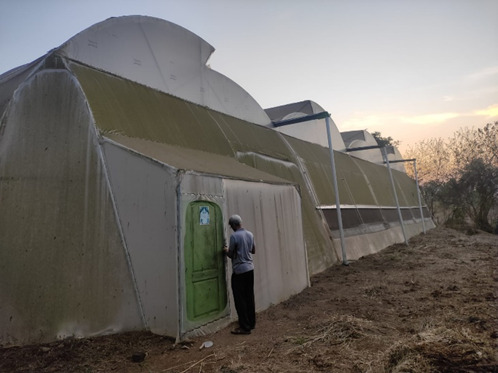
3. Advantages of Polyhouse Farming: The best Polyhouse Projects in india initiated by IGO Agritech Farms boast several advantages over traditional open-field farming. Firstly, they provide a shield against harsh weather elements, protecting crops from extreme temperatures, heavy rains, and strong winds. Secondly, polyhouses extend the growing season, allowing farmers to cultivate crops throughout the year, thus maximizing yields and profits. Additionally, the controlled environment significantly reduces the need for pesticides and fertilizers, making it an eco-friendly alternative.

5. Promoting Organic Farming: IGO Agritech Farms takes pride in promoting organic farming practices within their polyhouses. By eliminating the use of synthetic chemicals and embracing natural pest control methods, they ensure that the produce is healthier, free from harmful residues, and appealing to eco-conscious consumers.
6. Empowering Local Farmers: Beyond the technology and innovation, IGO Agritech Farms is dedicated to empowering local farmers. Through educational programs, training workshops, and collaborations, they share their expertise and knowledge, enabling farmers to adopt modern farming techniques and improve their livelihoods.
Conclusion: IGO Agritech Farms provide best Polyhouse Projects in Chennai symbolize the transformational power of agriculture when paired with innovation and sustainability. Their commitment to reshaping the agricultural landscape and empowering farmers serves as an inspiring model for the future of farming. As we face the challenges of feeding a growing global population, IGO Agritech Farms stands as a beacon of hope, offering a glimpse into a world where sustainable agriculture thrives and the future looks brighter than ever before.
To Know More Details Contact us
Contact: 7397789803, 7397789804, 7397789805
Mail: [email protected]
Website: www.igoagritechfarms.com
Our Other Projects
IGO Hydroponics | IGO Open Cultivation | IGO Vertical Farming | IGO Buyback | IGO JV Project |IGO Goat Farming | IGO Fish Farming | IGO Floriculture| IGO Agri Estate.
#agriculture#hydroponics indoor farming projects#open cultivation#marketing#digitalmarketing#rooftop garden
2 notes
·
View notes
Text
Skyblock Challenges: Overcoming Obstacles and Achieving Success
In the vast world of Minecraft, there is a popular game mode known as Skyblock that has captured the hearts of players everywhere. Skyblock presents a unique and thrilling challenge by placing players on a small island suspended in the sky, with limited resources and the daunting task of building a thriving civilization from scratch. With perseverance, creativity, and strategic thinking, players can overcome obstacles and achieve remarkable success in this challenging game mode.
One of the first obstacles players encounter in Skyblock is the scarcity of resources. With only a small island at their disposal, players must carefully manage their limited supply of blocks, tools, and items. Every decision counts, as a single misplaced block or wasted resource could spell disaster. This scarcity pushes players to think creatively and find innovative solutions to overcome challenges.
To overcome the resource scarcity, players must explore different strategies such as tree farming, mob grinders, and efficient mining techniques. By strategically placing saplings and using bone meal to accelerate their growth, players can ensure a steady supply of wood for construction and crafting. Mob grinders can be built to automate the collection of valuable resources from hostile creatures, providing an alternative source of rare items. Additionally, efficient mining techniques, such as branch mining or strip mining, can maximize the yield of valuable ores, allowing players to expand their capabilities and progress further.
Another significant challenge in Skyblock is the lack of space. With a small island as their starting point, players must utilize every inch of land effectively to build essential structures and expand their empire. Creative building techniques become vital in optimizing space utilization and achieving the desired results.
Players often employ vertical building methods, such as towering structures or multi-level farms, to maximize their use of space. Farms can be designed with automatic redstone mechanisms to save space and increase efficiency. By carefully planning and organizing their island layout, players can create an organized and functional environment that supports their progress and helps them reach their goals.
In addition to resource scarcity and limited space, players must also tackle various gameplay challenges to achieve success in Skyblock. These challenges include battling powerful mobs, completing difficult quests, and obtaining rare items. With each challenge conquered, players unlock new opportunities and rewards, further fueling their motivation to keep pushing forward.
Overcoming these obstacles requires strategic thinking and careful preparation. Players need to gather the right equipment, enchant their gear, and develop combat strategies to defeat formidable enemies. Completing quests and obtaining rare items often involves trading with non-player characters (NPCs) or venturing into dangerous areas in search of valuable loot. Players must carefully plan their actions, balancing risk and reward to maximize their chances of success.
Skyblock is not just about overcoming challenges; it is also a platform for players to showcase their creativity and imagination. With limited resources and space, players are forced to think outside the box and come up with unique solutions to problems. Whether it's designing elaborate redstone contraptions, creating stunning architectural structures, or constructing intricate automated farms, the possibilities for creativity are endless.
The success achieved in Skyblock goes beyond the game itself. It fosters skills such as problem-solving, critical thinking, and perseverance, which are valuable in the real world as well. The ability to adapt to challenging situations, think creatively, and work diligently towards a goal is a valuable asset that can be applied to various aspects of life.
Skyblock challenges players to step out of their comfort zones and embrace the unknown. It encourages them to overcome adversity, develop resilience, and unlock their potential for greatness. The satisfaction derived from conquering seemingly insurmountable obstacles and achieving success is unparalleled, making Skyblock a truly rewarding and immersive experience.
BLACKGROW.COM
So, if you're seeking a thrilling and challenging adventure that will test your skills and push you to your limits, give Skyblock a try. Embrace the obstacles, harness your creativity, and embark on a journey of resilience and triumph. Skyblock awaits, ready to reward your efforts and inspire you to overcome any obstacle that comes your way.
#minecraft skyblock servers#skyblock servers#SKYBLOCK#minecraft servers skyblock#minecraft skyblock server#MINECRAFT SKYBLOCK#skyblock minecraft servers
2 notes
·
View notes
Text
سمو الشيخ حمدان بن محمد : زرت مزرعة "بستانِكَ" في دبي، أكبر مزرعة رأسية تعتمد على الزراعة المائية في العالم، والتي افتتحتها طيران الإمارات باستثمارات تصل إلى 150 مليون درهم وبطاقة إنتاجية تصل إلى مليون كيلوجرام من الخضروات الورقية سنوياً.
سمو الشيخ حمدان بن محمد : افتتاح مزرعة "بستانِكَ" في دبي يعكس رؤية محمد بن راشد لتوظيف أحدث وسائل التكنولوجيا الذكية وتبني التقنيات المتقدمة في تنفيذ المشاريع الزراعية لتحقيق الأمن الغذائي والاكتفاء الذاتي من احتياجاتنا.
H.H Sheikh Hamdan bin Mohammed : I toured Bustanica, the world’s largest vertical farm recently opened in Dubai by Emirates Airline at an investment of AED150 million and with an annual production capacity of 1 million kg of leafy greens.
H.H Sheikh Hamdan bin Mohammed : The inauguration of Bustanica in Dubai reflects the vision of Mohammed bin Rashid to apply modern farming techniques to accelerate self-sufficiency in fresh food produce and support sustainability.
___________________________________
زار سمو الشيخ حمدان بن محمد بن راشد آل مكتوم ولي عهد دبي، مزرعة "بستانِكَ" في دبي التي افتتحتها "طيران الإمارات"، وهي أكبر مزرعة رأسية تعتمد على الزراعة المائية في العالم.
H.H Sheikh Hamdan bin Mohammed bin Rashid Al Maktoum, Crown Prince of Dubai, tours Bustanica, the world’s largest vertical farm in Dubai, the facility was developed by Emirates Crop One.
Tuesday, 16 August 2022 الثلاثاء



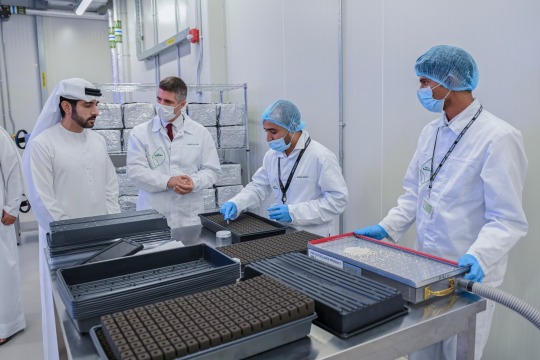

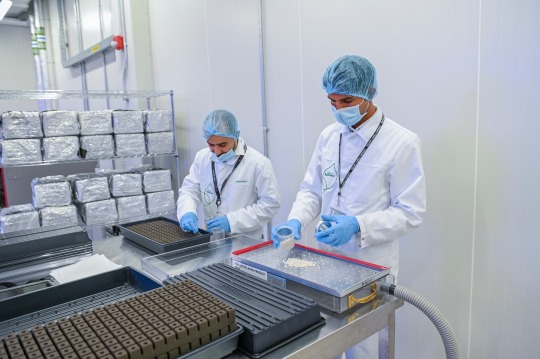
17 notes
·
View notes
Photo

Microgreens and Vertical Farming for Food or Profit:
Vertical farming is the practice of producing food in vertically stacked layers, such as in a skyscraper, used warehouse, or shipping container. The modern ideas of vertical farming use indoor farming techniques and controlled-environment agriculture (CEA) technology, where all environmental factors can be controlled.
MicroGreens are a tiny form of young edible greens produced from vegetable, herb or other plants. They range in size from one to one and a half inches long, including the stem and leaves. A microgreen has a single central stem.
A Vertical Farm of MicroGreens uses pure water, conventional seeds on 100% organic coconut fiber hydroponic growing pads, as the seed bed, and natural bamboo stakes to keep the fiber off the tray bottoms resulting a true hydroponic environment with seeds-to-harvest in about a week. They sell to local restaurants, with roots attached, for about $30 (in 2016) per tray. They use about 1 cup of water per day per tray and electricity for 12-volt LED lighting for an estimated total cost of $6 (2016 prices) to grow one tray.
Video: How Vertical Farming Works
Information Link
City-Hydro - Baltimore, MD
Oh My Greens - Charleston, WV
See Also:
Free Microgreens Training
Vertical Farming at Home
How to Grow Microgreens
Replenishable Water and Food Sources
[Reference Link]
Microgreens Supplies on Amazon
[14-Point Emergency Preps Checklist]
[11-Cs Basic Emergency Kit]
[Learn to be More Self-Sufficient]
[The Ultimate Preparation]
[5six7 Menu]
#microgreens#verticalfarming#agriculture#food#prepper#survival#diy#shtf#garden#indoor garden#farming
4 notes
·
View notes